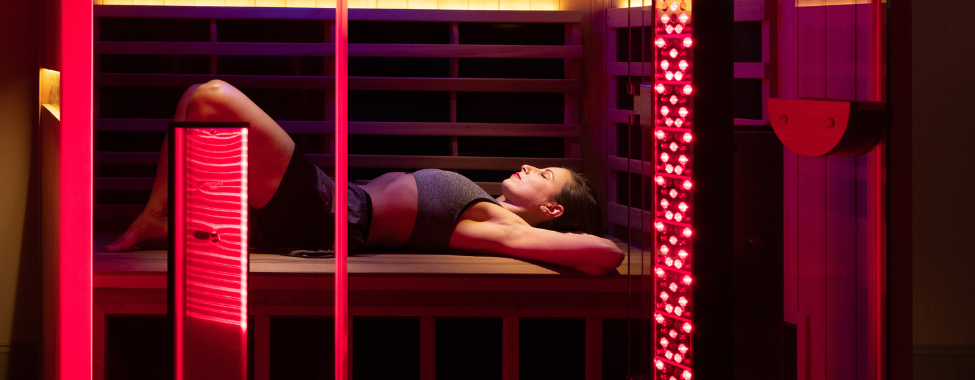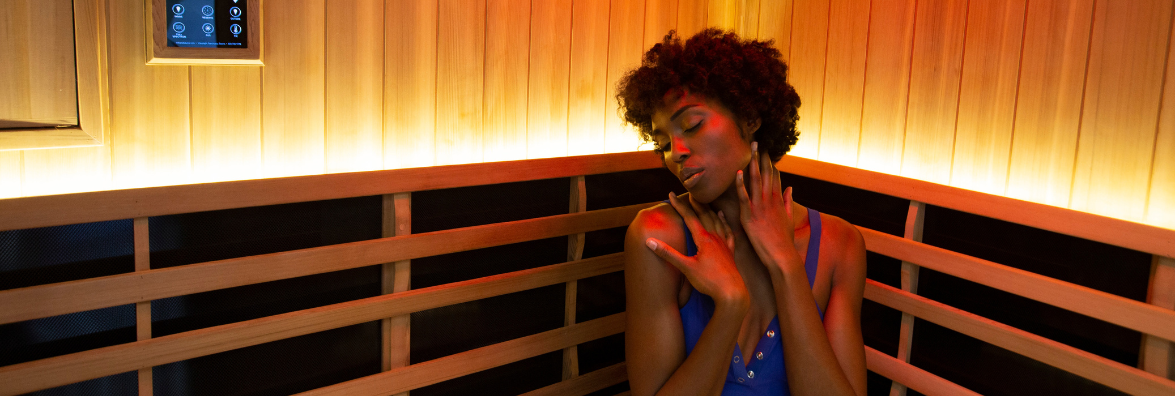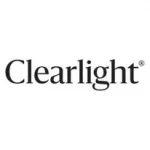- 14 Aug, 2025
- /
- Clearlight Infrared Saunas
- /
- No Comments
Red Light Therapy vs Chromotherapy: What’s the Difference?
Understanding the distinction between red light therapy and chromotherapy is key to optimizing your wellness. While red light focuses on aiding boosted cellular repair and energy production, chromotherapy uses color to help balance mental and physical health, offering complementary benefits for holistic healing.
What is Red Light Therapy?
Red light therapy (RLT), also known as photobiomodulation, uses low-level red or near-infrared light wavelengths to penetrate the skin and stimulate various biological processes. The most common wavelengths range from 600 to 850 nanometers, which have been widely studied for their effects on cellular energy production, inflammation reduction, and tissue repair. The Clearlight red light towers use a powerful combination of red light (650nm) and near infrared (850nm) wavelengths to offer the most therapeutic experience from a red light device.
When these wavelengths enter the body, they help stimulate the mitochondria – the energy centers of your cells – to produce more adenosine triphosphate (ATP). More ATP means better cellular function, faster healing, and improved resilience against stress and injury.
Benefits of Red Light Therapy
- Accelerates tissue repair and wound healing
- Reduces inflammation in muscles and joints
- Improves skin tone and elasticity by boosting collagen production
- Enhances muscle recovery after workouts
- Supports mood and cognitive performance through improved circulation and reduced inflammation
Red light therapy is often used in clinical, spa, and home wellness settings. It’s especially popular when paired with infrared saunas, as the combined heat and light therapy can multiply the benefits.

What is Chromotherapy?
Chromotherapy, or color therapy, is an ancient wellness practice based on the idea that different colors can influence mental, emotional, and physical well-being. Unlike red light therapy, which uses a specific wavelength for physical healing, chromotherapy leverages the visible color spectrum to affect mood, balance energy, and promote harmony.
Each color in chromotherapy corresponds to a different frequency and is believed to target specific wellness goals:
- Blue: Calming, anti-inflammatory
- Green: Balancing and grounding
- Yellow: Energizing and mood-lifting
- Purple: Meditative and spiritually soothing
- Red: Stimulating and warming (note: different from red light therapy wavelengths)
These colors can be delivered through LED light panels or sauna systems equipped with chromotherapy lighting.
Benefits of Chromotherapy
- Supports emotional balance and stress relief
- Improves sleep quality through calming hues
- Enhances focus and creativity with energizing tones
- Balances energy centers (chakras) in holistic healing practices
Chromotherapy is often used in wellness centers, spas, and increasingly in residential saunas for a more immersive relaxation experience.
Key Differences Between Red Light Therapy and Chromotherapy
Although both therapies involve light, their mechanisms and outcomes differ significantly. In short, red light therapy is more rooted in biological healing, while chromotherapy is centered around emotional and sensory experience.
| Feature | Red Light Therapy | Chromotherapy |
| Purpose | Cellular regeneration, healing, energy | Mood enhancement, emotional balance |
| Wavelengths | 600-850 nm (visible red to invisible infrared) |
380-750 nm (visible light spectrum) |
| Mechanism | Stimulates mitochondria to produce ATP | Engages the nervous system through color response |
| Scientific Backing | Extensively studied in clinical trials | Emerging research; mostly anecdotal or holistic |
| Applications | Pain relief, skin care, recovery | Stress reduction, mood support, aesthetic ambiance |
In practical terms, red light therapy is commonly applied to address physical concerns such as pain relief, skin rejuvenation, and post-exercise recovery. Chromotherapy is used to support stress reduction, mental clarity, and the creation of a soothing ambiance.
Incorporating RLT and Chromotherapy Into Your Routine
Red light therapy and chromotherapy aren’t mutually exclusive. In fact, using them together can provide a layered wellness experience that addresses both body and mind. Use chromotherapy during mindfulness practices (meditation, breathwork) while reserving red light for more targeted recovery sessions.
Integrating light therapies into your daily habits can help you maximize their benefits without disrupting your schedule. Here are some time-based suggestions:
Morning: Wake Up and Energize
- Red Light: Use a red light panel for 10-15 minutes after waking. It can help reset your circadian rhythm and give a natural energy boost.
- Chromotherapy: Try yellow or green lighting to stimulate alertness and support focus without overstimulation.
Post-Workout: Recover and Rebuild
- Red Light: A quick red light session post-exercise can help reduce muscle soreness and accelerate recovery.
- Chromotherapy: Use cooling blue tones to promote relaxation and reduce any post-exercise tension or heat.
Evening: Wind Down and Relax
- Red Light: Keep sessions short (5-10 minutes) before bed to support melatonin production and relaxation.
- Chromotherapy: Incorporate purple or blue lighting in your space or sauna to ease into a restful state.
Consistency is key. Like any wellness tool, benefits build over time with regular use. When used together in your wellness routine, RLT and chromotherapy can offer a comprehensive wellness approach – supporting both physiological health and emotional balance.

Infrared Sauna Integration
Many infrared saunas now come with both red light and chromotherapy options. Here’s how to maximize both:
- Start with chromotherapy as you ease into your sauna session. Use calming colors like green or blue to settle the mind.
- Activate red light therapy once your body temperature rises. The heat will enhance blood flow and absorption, boosting red light’s effects on muscle recovery and skin health.
- Finish with a cool-down in low blue or purple lighting to signal your nervous system that it’s time to rest.
Harnessing the Power of Light for Health and Wellness
Understanding the difference between red light therapy and chromotherapy empowers you to make more informed decisions for your wellness routine. Red light therapy targets deep biological functions like cellular repair and energy production, making it ideal for physical recovery and anti-aging. Chromotherapy, on the other hand, provides a more sensory, emotional experience that can balance mood and enhance relaxation.
Used on their own or in tandem, especially in an infrared sauna environment, these light therapies can elevate your wellness setup. With just a few adjustments to your daily schedule, you can tap into the combined power of light to feel better, recover faster, and live more vibrantly.
 Canada
Canada Australia
Australia New Zealand
New Zealand Germany
Germany UK
UK EU
EU Ireland
Ireland Malaysia
Malaysia China
China Japan
Japan



